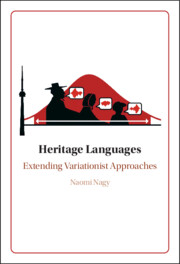Book contents
- Heritage Languages
- Heritage Languages
- Copyright page
- Epigraph
- Contents
- Figures
- Tables
- Acknowledgements
- Abbreviations
- 1 What Are Heritage Languages and Why Should We Study Them?
- 2 Experimental and Variationist Research on Heritage Languages
- 3 The Toronto Context
- 4 HLVC Methods and Tools
- 5 Cross-Variety Comparisons
- 6 Cross-Language Comparisons
- 7 Heritage Cantonese
- 8 Indexicality in Heritage Languages
- 9 Working with Heritage Languages in Linguistics Classes
- 10 What Heritage Language Speakers Tell Us about Language Variation and Change
- Bibliography
- Index
4 - HLVC Methods and Tools
Published online by Cambridge University Press: 09 July 2024
- Heritage Languages
- Heritage Languages
- Copyright page
- Epigraph
- Contents
- Figures
- Tables
- Acknowledgements
- Abbreviations
- 1 What Are Heritage Languages and Why Should We Study Them?
- 2 Experimental and Variationist Research on Heritage Languages
- 3 The Toronto Context
- 4 HLVC Methods and Tools
- 5 Cross-Variety Comparisons
- 6 Cross-Language Comparisons
- 7 Heritage Cantonese
- 8 Indexicality in Heritage Languages
- 9 Working with Heritage Languages in Linguistics Classes
- 10 What Heritage Language Speakers Tell Us about Language Variation and Change
- Bibliography
- Index
Summary
The HLVC project applies consistent methods of data collection, analysis, and interpretation to a range of languages and dependent variables. This is meant to mitigate the pattern of diverse findings from diverse studies that may partially result from diverse methods. This chapter therefore describes how the corpus is constructed, focusing on the cross-linguistic, cross-generational, and multi-method design, and gives details about recruiting, recording, and transcription of the sociolinguistic interview, the ethnic orientation questionnaire, the picture description task, and the consent procedure. It then describes the workflow for data processing and metadata construction, describing both how the corpus is organized (to be useful to additional researchers) and how we have analyzed variation of a number of variables to date. These include prodrop, case-marking, VOT, and (r) across multiple languages, apocope and differential object marking in Italian, and tone mergers, classifiers, motion-even marking, denasalization (an element of so-called lazy pronunciation, 懶音 laan5 jam1), and vowel space in Cantonese. It details the methods of analyzing ethnic orientation and several proxies for fluency (speech rate, vocabulary size, language-switching measures). Finally, it describes the methods used for constructing and comparing mixed-effects models for cross-variety comparisons in order to distinguish contact-induced change, internal change, and identity-marking variation.
Keywords
- Type
- Chapter
- Information
- Heritage LanguagesExtending Variationist Approaches, pp. 37 - 91Publisher: Cambridge University PressPrint publication year: 2024

